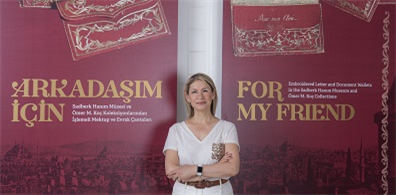The story of an exhibition: ‘For My Friend’

The idea for curating an exhibition, which eventually came to life with the “For My Friend” project, was first discussed in 2020 when Ömer M. Koç, Chairman of the Executive Committee, Sadberk Hanım Museum, proposed creating a catalog of the embroidered letter and document wallets in his private collection to Hülya Bilgi, the curator of the exhibition. Sadberk Hanım Museum, a Vehbi Koç Foundation institution, now hosts the exhibition that features a rich selection of embroidered letter and document wallets from the museum's own collection and the private collection of Ömer M. Koç.
Hülya Bilgi says that she was very excited about the idea of bringing such an exhibition to life: “No exhibition in a similar scope was held to date. We started by compiling the embroidered letter and document wallets from the private collection of Ömer M. Koç and our museum collection. We wanted to display the peak of Ottoman leather and embroidery craftsmanship through this rich selection. We also aimed to highlight Istanbul and Izmir, two cities where many of these wallets were made and in a way served as a depository of the empire at the time, hoping to draw attention to the importance of international diplomacy. I believe that the exhibition delivers these aspirations.”
The preparations for the project started with bringing together the two collections and continued with the restoration of some of the artifacts. As always, the experienced conservation team at Sadberk Hanım Museum worked meticulously to restore the exhibition pieces.
Gathering the exhibition pieces started on the day the idea came up and continued until April 2022. During the content creation process, the focus was on telling the advanced level of Ottoman leather craftsmanship at the time and how much it was valued. Another focus point was to communicate the influence of the 18th century on arts and crafts and its reflections on embroidery because that was the period when many Europeans visited the Ottoman land and diplomacy gained more importance especially as a result of the new commercial, political and cultural relations established with Europe. It was also an era when the Ottomans and the West became more familiarized with each other.
During the preparation process of the exhibition, which features 76 letter and 15 document wallets with similar styles, the focus was on creating a story that would keep the visitor engaged. For this purpose, the starting point was to go through the most critical points of the subject matter and consider the actual message that needed to be conveyed. Hülya Bilgi, the curator of the exhibition, talks about the process they followed next: “The production of these wallets, which were personalized with names, dates and cities – Istanbul (Constantinople) and Izmir (Smyrna) – inspired the exhibition team to study the leather craftsmanship and embroidery of the period. In the process, they also wanted to address the importance of corresponding by letters at the time and the writers of those letters and documents. The 18th century, when most of these wallets were made, was a period when different influences were felt more significantly and relations with the West developed. It was also a period of the East and the West influencing one another. As a result of the relations built between the Ottomans and the Europeans, many diplomats, merchants, travelers and painters visited Istanbul, the Ottoman capital, and the port city of Izmir, the gateway connecting Anatolia and Europe. So, how these people saw the Ottoman Empire and Ottoman life at the time, and how the letter and document wallets, which constituted a small but quite popular, authentic Ottoman leather craftsmanship, were made by whom, informed the structure of our exhibition story. In other words, we were driven to describe that period, the scene, and the actors.”
The exhibition’s teachings
The exhibition highlights the qualities of the pieces on display while the context and narrative focus on Ottoman craftsmanship, leatherwork and embroidery, hinting at the importance of the material culture in diplomatic relations. The wallets, including three made of velvet fabric and the others made of Saffian leather, bear various dates, indicating that they span a period of more than a century and a half, from 1669 to 1835.
Looking at the composition of the wallets, the curation and the holistic perspective of the exhibition, the fusion of Eastern and Western cultures can be followed through the various wallet patterns. For instance, elements of Ottoman classical arts such as Hatayi embellishments, peonies, rosettes, and tulips play a major role in the composition on the embroideries on the early wallets when diplomatic traffic was relatively low. The embroidered flower motifs on the corners strictly adhere to the principle of infinity and symmetry, a characteristic of Ottoman art. After the 17th century, when traditional patterns were followed to a great extent, the 18th century, and particularly the period called the Tulip Age, when Sultan Ahmed III led a modernization movement and Westernization efforts, saw a departure from classical patterns in architecture and decorative arts. While the early years of that period still showed a loyalty to the classical tradition, the second half of the century saw a heightened influence of Western art, particularly of styles such as baroque and rococo. Sprinkled floral bouquets, garlands, curtains, flowing ribbons and bows, flowers overflowing from vases and baskets, fruit baskets, sun rays, crests and tugras begin to gain prominence among the Ottoman patterns. Western styles guide the choice of both motifs and materials. In addition to silk, silver and gold threads, reminiscent of the gilded baroque and rococo arts, are used heavily. These European influences are widely seen on the letter and document wallets featured in the exhibition and the accompanying book.



